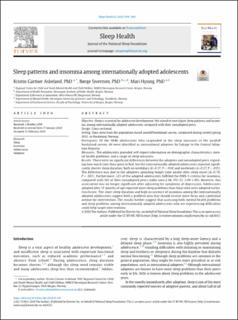| dc.contributor.author | Askeland, Kristin Gärtner | |
| dc.contributor.author | Sivertsen, Børge | |
| dc.contributor.author | Hysing, Mari | |
| dc.date.accessioned | 2021-07-01T11:30:45Z | |
| dc.date.available | 2021-07-01T11:30:45Z | |
| dc.date.created | 2021-01-20T10:49:25Z | |
| dc.date.issued | 2020 | |
| dc.Published | Sleep Health. 2020, 6 (5), 594-600. | |
| dc.identifier.issn | 2352-7218 | |
| dc.identifier.uri | https://hdl.handle.net/11250/2762805 | |
| dc.description.abstract | Objective
Sleep is essential for adolescent development. We aimed to investigate sleep patterns and insomnia among internationally adopted adolescents compared with their nonadopted peers.
Design
Cross-sectional.
Setting
Data stem from the population-based youth@hordaland-survey, conducted during winter/spring 2012, in Hordaland, Norway.
Participants
Of the 9846 adolescents who responded to the sleep measures in the youth@hordaland-survey, 44 were identified as international adoptees by linkage to the Central Adoption Registry.
Measures
The adolescents provided self-report information on demographic characteristics, mental health problems, and a range of sleep measures.
Results
There were no significant differences between the adoptees and nonadopted peers regarding how much time they spent in bed, but the internationally adopted adolescents reported significantly shorter sleep duration, both on weekdays (d=0.37, P = .014) and weekends (d=0.37, P = .015). The difference was due to the adoptees spending longer time awake after sleep onset (d=0.78, P > .001). Furthermore, 32% of the adopted adolescents fulfilled the DMS-5 criteria for insomnia, compared with 18% of their nonadopted peers (odds ratio 2.06, 95% CI: 1.09-3.90). However, this association was no longer significant after adjusting for symptoms of depression. Adolescents adopted after 12 months of age reported more sleep problems than those who were adopted earlier.
Conclusion
The short sleep duration and high occurrence of insomnia among the internationally adopted adolescents suggest both a problem area that should receive more focus and a potential avenue for intervention. The results further suggest that assessing both mental health problems and sleep problems among internationally adopted adolescents who are experiencing difficulties could help target interventions. | en_US |
| dc.language.iso | eng | en_US |
| dc.publisher | Elsevier | en_US |
| dc.rights | Attribution-NonCommercial-NoDerivatives 4.0 Internasjonal | * |
| dc.rights.uri | http://creativecommons.org/licenses/by-nc-nd/4.0/deed.no | * |
| dc.title | Sleep patterns and insomnia among internationally adopted adolescents | en_US |
| dc.type | Journal article | en_US |
| dc.type | Peer reviewed | en_US |
| dc.description.version | publishedVersion | en_US |
| dc.rights.holder | Copyright 2020 The Authors | en_US |
| cristin.ispublished | true | |
| cristin.fulltext | postprint | |
| cristin.qualitycode | 1 | |
| dc.identifier.doi | 10.1016/j.sleh.2020.02.011 | |
| dc.identifier.cristin | 1875252 | |
| dc.source.journal | Sleep Health | en_US |
| dc.source.40 | 6 | |
| dc.source.14 | 5 | |
| dc.source.pagenumber | 594-600 | en_US |
| dc.identifier.citation | Sleep Health. 2020, 6(5), 594-600 | en_US |
| dc.source.volume | 6 | en_US |
| dc.source.issue | 5 | en_US |

